MAA725: Advance Accounting Principles and Practice Assignment
VerifiedAdded on 2022/08/24
|13
|2208
|27
Homework Assignment
AI Summary
This assignment solution addresses the complexities of accounting for financial instruments under IFRS, with specific reference to IAS 32, IFRS 7, and IAS 39. It provides a detailed discussion on the classification of financial instruments as either debt or equity, emphasizing the importance of contractual terms over legal form. The solution explores the definitions and characteristics of financial assets, financial liabilities, and equity instruments, including various categories like common stock and convertible debentures. It highlights the impact of proper classification on key financial metrics such as the gearing ratio and earnings per share (EPS). Furthermore, the assignment includes journal entries for foreign exchange and references relevant accounting standards and literature. The solution also discusses the implications of the new standard AASB 9 for financial reporting, which provides new rules for the impairment of financial assets.

Running head: ADVANCE ACCOUNTING
ADVANCE ACCOUNTING
Name of the Student
Name of the University
Author Note:
ADVANCE ACCOUNTING
Name of the Student
Name of the University
Author Note:
Paraphrase This Document
Need a fresh take? Get an instant paraphrase of this document with our AI Paraphraser

1ADVANCE ACCOUNTING
Table of Contents
Introduction......................................................................................................................................2
Discussion........................................................................................................................................2
Classification as liability or Equity..............................................................................................5
Conclusion.......................................................................................................................................7
Reference.......................................................................................................................................11
Table of Contents
Introduction......................................................................................................................................2
Discussion........................................................................................................................................2
Classification as liability or Equity..............................................................................................5
Conclusion.......................................................................................................................................7
Reference.......................................................................................................................................11
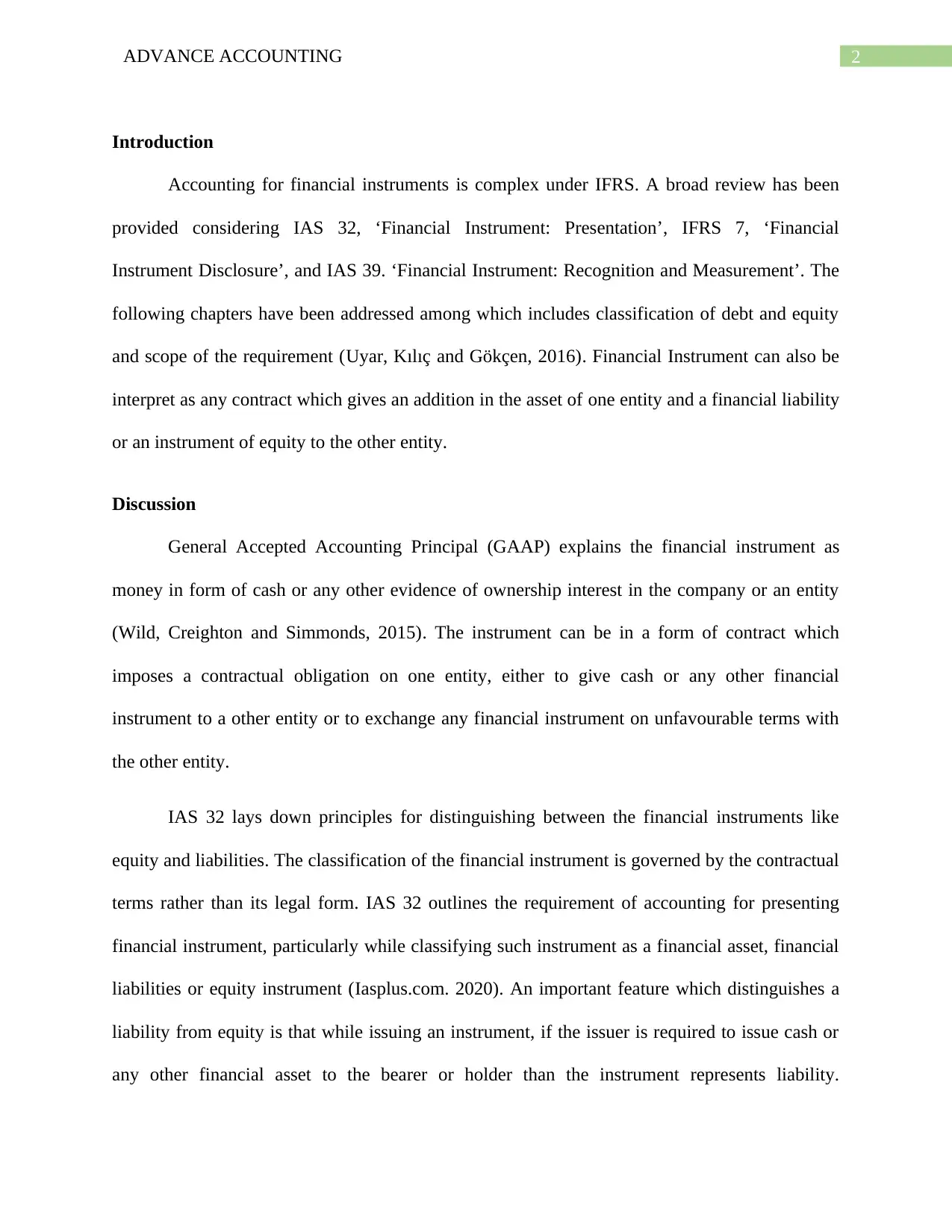
2ADVANCE ACCOUNTING
Introduction
Accounting for financial instruments is complex under IFRS. A broad review has been
provided considering IAS 32, ‘Financial Instrument: Presentation’, IFRS 7, ‘Financial
Instrument Disclosure’, and IAS 39. ‘Financial Instrument: Recognition and Measurement’. The
following chapters have been addressed among which includes classification of debt and equity
and scope of the requirement (Uyar, Kılıç and Gökçen, 2016). Financial Instrument can also be
interpret as any contract which gives an addition in the asset of one entity and a financial liability
or an instrument of equity to the other entity.
Discussion
General Accepted Accounting Principal (GAAP) explains the financial instrument as
money in form of cash or any other evidence of ownership interest in the company or an entity
(Wild, Creighton and Simmonds, 2015). The instrument can be in a form of contract which
imposes a contractual obligation on one entity, either to give cash or any other financial
instrument to a other entity or to exchange any financial instrument on unfavourable terms with
the other entity.
IAS 32 lays down principles for distinguishing between the financial instruments like
equity and liabilities. The classification of the financial instrument is governed by the contractual
terms rather than its legal form. IAS 32 outlines the requirement of accounting for presenting
financial instrument, particularly while classifying such instrument as a financial asset, financial
liabilities or equity instrument (Iasplus.com. 2020). An important feature which distinguishes a
liability from equity is that while issuing an instrument, if the issuer is required to issue cash or
any other financial asset to the bearer or holder than the instrument represents liability.
Introduction
Accounting for financial instruments is complex under IFRS. A broad review has been
provided considering IAS 32, ‘Financial Instrument: Presentation’, IFRS 7, ‘Financial
Instrument Disclosure’, and IAS 39. ‘Financial Instrument: Recognition and Measurement’. The
following chapters have been addressed among which includes classification of debt and equity
and scope of the requirement (Uyar, Kılıç and Gökçen, 2016). Financial Instrument can also be
interpret as any contract which gives an addition in the asset of one entity and a financial liability
or an instrument of equity to the other entity.
Discussion
General Accepted Accounting Principal (GAAP) explains the financial instrument as
money in form of cash or any other evidence of ownership interest in the company or an entity
(Wild, Creighton and Simmonds, 2015). The instrument can be in a form of contract which
imposes a contractual obligation on one entity, either to give cash or any other financial
instrument to a other entity or to exchange any financial instrument on unfavourable terms with
the other entity.
IAS 32 lays down principles for distinguishing between the financial instruments like
equity and liabilities. The classification of the financial instrument is governed by the contractual
terms rather than its legal form. IAS 32 outlines the requirement of accounting for presenting
financial instrument, particularly while classifying such instrument as a financial asset, financial
liabilities or equity instrument (Iasplus.com. 2020). An important feature which distinguishes a
liability from equity is that while issuing an instrument, if the issuer is required to issue cash or
any other financial asset to the bearer or holder than the instrument represents liability.
⊘ This is a preview!⊘
Do you want full access?
Subscribe today to unlock all pages.

Trusted by 1+ million students worldwide
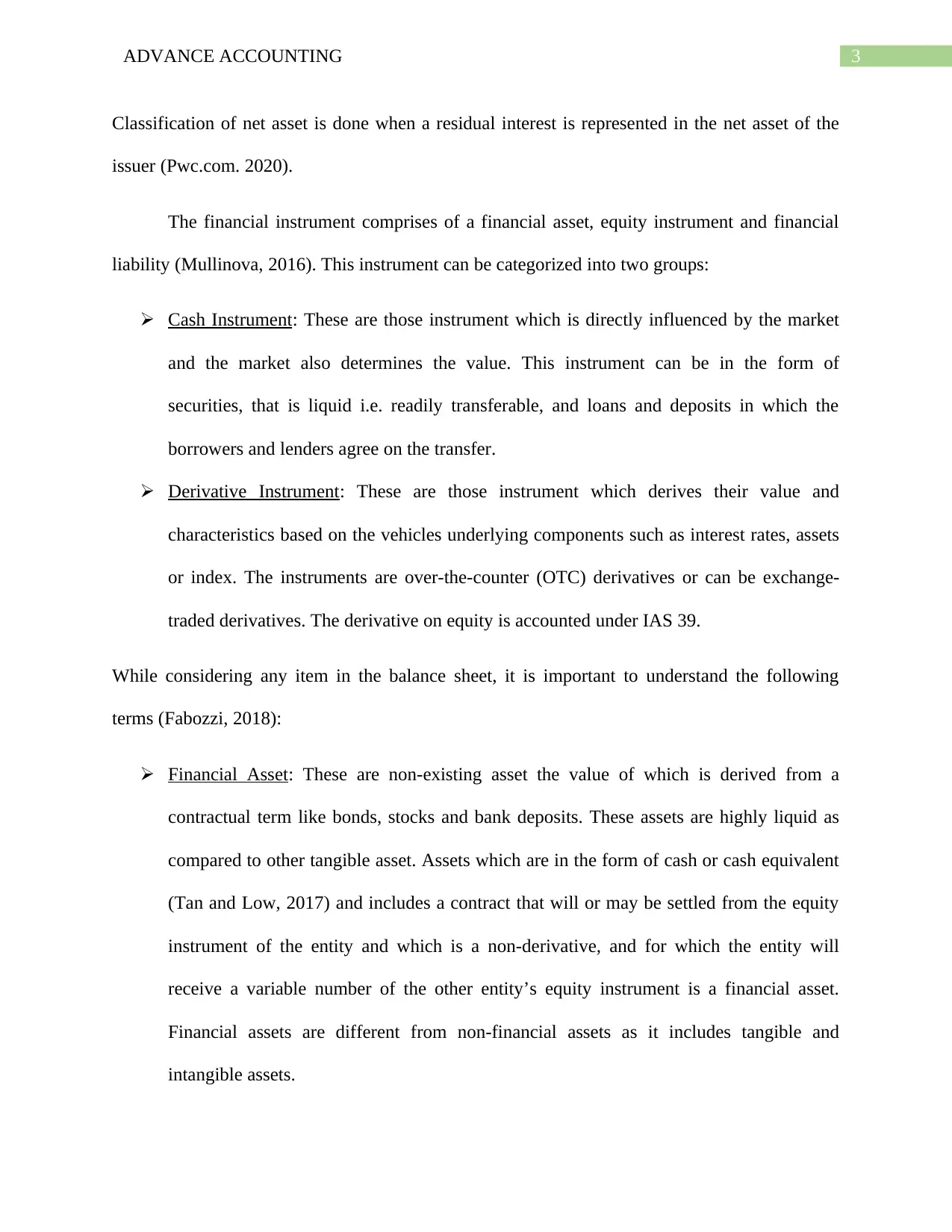
3ADVANCE ACCOUNTING
Classification of net asset is done when a residual interest is represented in the net asset of the
issuer (Pwc.com. 2020).
The financial instrument comprises of a financial asset, equity instrument and financial
liability (Mullinova, 2016). This instrument can be categorized into two groups:
Cash Instrument: These are those instrument which is directly influenced by the market
and the market also determines the value. This instrument can be in the form of
securities, that is liquid i.e. readily transferable, and loans and deposits in which the
borrowers and lenders agree on the transfer.
Derivative Instrument: These are those instrument which derives their value and
characteristics based on the vehicles underlying components such as interest rates, assets
or index. The instruments are over-the-counter (OTC) derivatives or can be exchange-
traded derivatives. The derivative on equity is accounted under IAS 39.
While considering any item in the balance sheet, it is important to understand the following
terms (Fabozzi, 2018):
Financial Asset: These are non-existing asset the value of which is derived from a
contractual term like bonds, stocks and bank deposits. These assets are highly liquid as
compared to other tangible asset. Assets which are in the form of cash or cash equivalent
(Tan and Low, 2017) and includes a contract that will or may be settled from the equity
instrument of the entity and which is a non-derivative, and for which the entity will
receive a variable number of the other entity’s equity instrument is a financial asset.
Financial assets are different from non-financial assets as it includes tangible and
intangible assets.
Classification of net asset is done when a residual interest is represented in the net asset of the
issuer (Pwc.com. 2020).
The financial instrument comprises of a financial asset, equity instrument and financial
liability (Mullinova, 2016). This instrument can be categorized into two groups:
Cash Instrument: These are those instrument which is directly influenced by the market
and the market also determines the value. This instrument can be in the form of
securities, that is liquid i.e. readily transferable, and loans and deposits in which the
borrowers and lenders agree on the transfer.
Derivative Instrument: These are those instrument which derives their value and
characteristics based on the vehicles underlying components such as interest rates, assets
or index. The instruments are over-the-counter (OTC) derivatives or can be exchange-
traded derivatives. The derivative on equity is accounted under IAS 39.
While considering any item in the balance sheet, it is important to understand the following
terms (Fabozzi, 2018):
Financial Asset: These are non-existing asset the value of which is derived from a
contractual term like bonds, stocks and bank deposits. These assets are highly liquid as
compared to other tangible asset. Assets which are in the form of cash or cash equivalent
(Tan and Low, 2017) and includes a contract that will or may be settled from the equity
instrument of the entity and which is a non-derivative, and for which the entity will
receive a variable number of the other entity’s equity instrument is a financial asset.
Financial assets are different from non-financial assets as it includes tangible and
intangible assets.
Paraphrase This Document
Need a fresh take? Get an instant paraphrase of this document with our AI Paraphraser
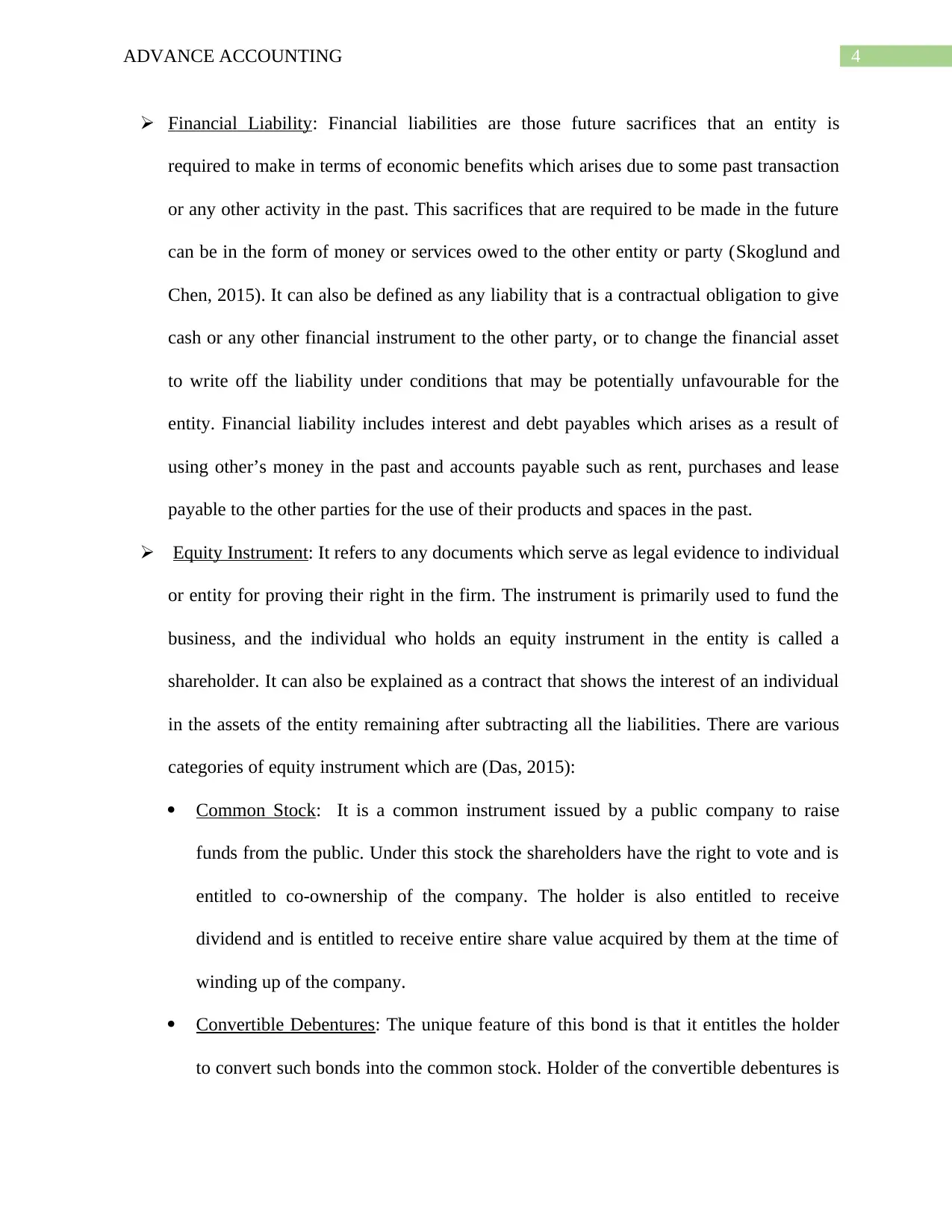
4ADVANCE ACCOUNTING
Financial Liability: Financial liabilities are those future sacrifices that an entity is
required to make in terms of economic benefits which arises due to some past transaction
or any other activity in the past. This sacrifices that are required to be made in the future
can be in the form of money or services owed to the other entity or party (Skoglund and
Chen, 2015). It can also be defined as any liability that is a contractual obligation to give
cash or any other financial instrument to the other party, or to change the financial asset
to write off the liability under conditions that may be potentially unfavourable for the
entity. Financial liability includes interest and debt payables which arises as a result of
using other’s money in the past and accounts payable such as rent, purchases and lease
payable to the other parties for the use of their products and spaces in the past.
Equity Instrument: It refers to any documents which serve as legal evidence to individual
or entity for proving their right in the firm. The instrument is primarily used to fund the
business, and the individual who holds an equity instrument in the entity is called a
shareholder. It can also be explained as a contract that shows the interest of an individual
in the assets of the entity remaining after subtracting all the liabilities. There are various
categories of equity instrument which are (Das, 2015):
Common Stock: It is a common instrument issued by a public company to raise
funds from the public. Under this stock the shareholders have the right to vote and is
entitled to co-ownership of the company. The holder is also entitled to receive
dividend and is entitled to receive entire share value acquired by them at the time of
winding up of the company.
Convertible Debentures: The unique feature of this bond is that it entitles the holder
to convert such bonds into the common stock. Holder of the convertible debentures is
Financial Liability: Financial liabilities are those future sacrifices that an entity is
required to make in terms of economic benefits which arises due to some past transaction
or any other activity in the past. This sacrifices that are required to be made in the future
can be in the form of money or services owed to the other entity or party (Skoglund and
Chen, 2015). It can also be defined as any liability that is a contractual obligation to give
cash or any other financial instrument to the other party, or to change the financial asset
to write off the liability under conditions that may be potentially unfavourable for the
entity. Financial liability includes interest and debt payables which arises as a result of
using other’s money in the past and accounts payable such as rent, purchases and lease
payable to the other parties for the use of their products and spaces in the past.
Equity Instrument: It refers to any documents which serve as legal evidence to individual
or entity for proving their right in the firm. The instrument is primarily used to fund the
business, and the individual who holds an equity instrument in the entity is called a
shareholder. It can also be explained as a contract that shows the interest of an individual
in the assets of the entity remaining after subtracting all the liabilities. There are various
categories of equity instrument which are (Das, 2015):
Common Stock: It is a common instrument issued by a public company to raise
funds from the public. Under this stock the shareholders have the right to vote and is
entitled to co-ownership of the company. The holder is also entitled to receive
dividend and is entitled to receive entire share value acquired by them at the time of
winding up of the company.
Convertible Debentures: The unique feature of this bond is that it entitles the holder
to convert such bonds into the common stock. Holder of the convertible debentures is

5ADVANCE ACCOUNTING
entitled to a defined rate of interest irrespective of the profit of the company. These
bonds are popular for their profitable returns.
Preferred Stock: It is also a common stock which involves the holder’s participation
in the ownership of the company. The variation lies in the prior payments made at the
time of distribution of dividends or distribution at the time of winding up of the
company.
Depository Receipt: Investors holding the depository receipt has the benefits similar
to that of shareholder in every aspect.
Classification as liability or Equity.
As per IAS 32, the fundamental principal is to classify financial instrument either as an
equity instrument or financial liability according to the substance of the contract and from its
definition but not in its legal form. The decision regarding whether the item is financial liability
or equity should be made initially at the time of recognition and it should not be changed with
the change in the circumstances (Maglio, Agliata and Tuccillo, 2017).
Classification of the instrument as debt or equity is vital because it directly affects in the
valuation of gearing ratio, which is a critical measure that the financial user or stakeholders uses
to measure the financial risk of the entity. The distinction that will arise from improper
classification will also impact the profit of the company as the financial cost related with the
financial liabilities will be charged in the profit and statement which will result in an
understatement of profit and therefore lower will be the tax payable to the government.
Similarly, the dividends payable to the equity will be assigned from the profits, rather being
treated as an expense (Worthington, 2016). Treating the equity as liability will not only decrease
the profit but will also reduce the earning per share (EPS) of the company, thereby impacting the
entitled to a defined rate of interest irrespective of the profit of the company. These
bonds are popular for their profitable returns.
Preferred Stock: It is also a common stock which involves the holder’s participation
in the ownership of the company. The variation lies in the prior payments made at the
time of distribution of dividends or distribution at the time of winding up of the
company.
Depository Receipt: Investors holding the depository receipt has the benefits similar
to that of shareholder in every aspect.
Classification as liability or Equity.
As per IAS 32, the fundamental principal is to classify financial instrument either as an
equity instrument or financial liability according to the substance of the contract and from its
definition but not in its legal form. The decision regarding whether the item is financial liability
or equity should be made initially at the time of recognition and it should not be changed with
the change in the circumstances (Maglio, Agliata and Tuccillo, 2017).
Classification of the instrument as debt or equity is vital because it directly affects in the
valuation of gearing ratio, which is a critical measure that the financial user or stakeholders uses
to measure the financial risk of the entity. The distinction that will arise from improper
classification will also impact the profit of the company as the financial cost related with the
financial liabilities will be charged in the profit and statement which will result in an
understatement of profit and therefore lower will be the tax payable to the government.
Similarly, the dividends payable to the equity will be assigned from the profits, rather being
treated as an expense (Worthington, 2016). Treating the equity as liability will not only decrease
the profit but will also reduce the earning per share (EPS) of the company, thereby impacting the
⊘ This is a preview!⊘
Do you want full access?
Subscribe today to unlock all pages.

Trusted by 1+ million students worldwide
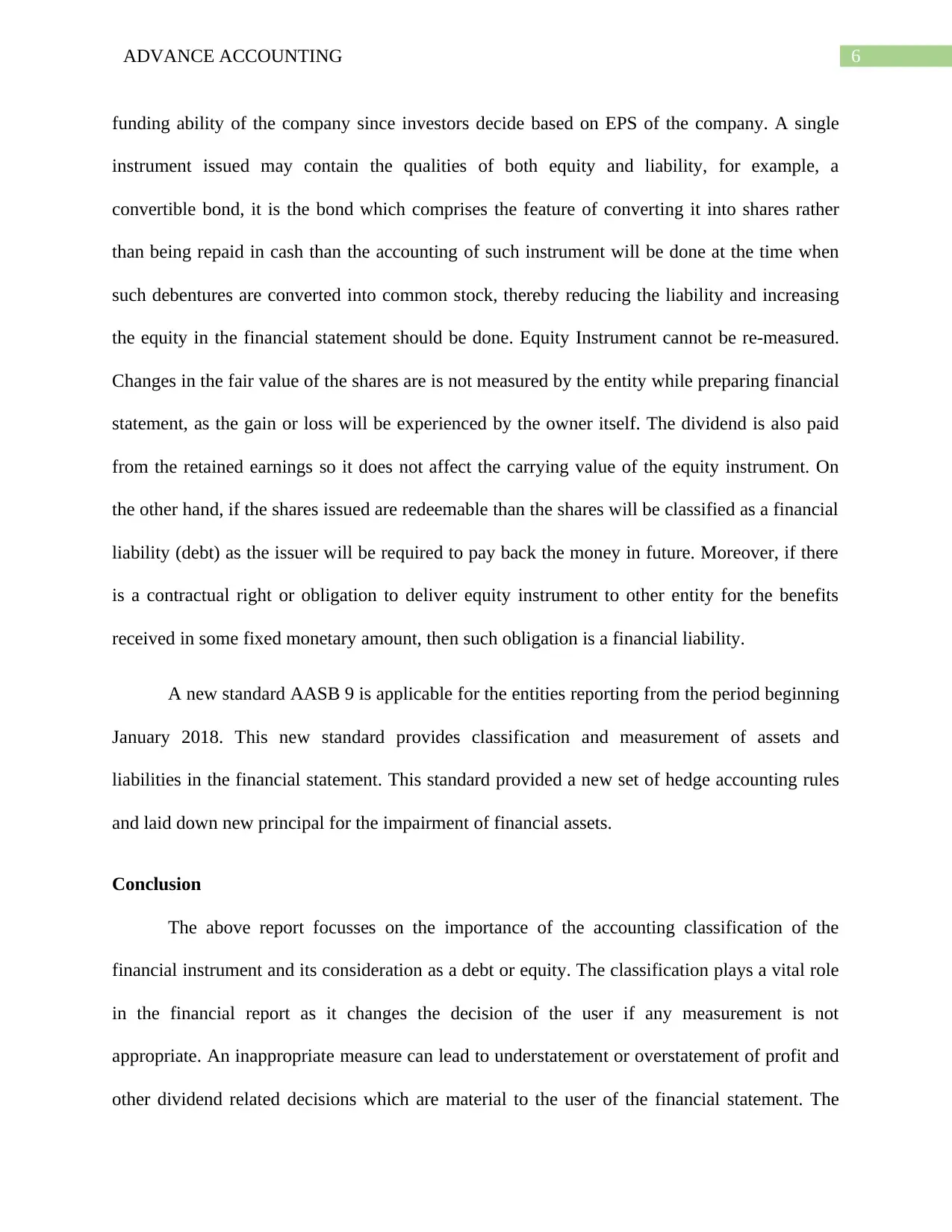
6ADVANCE ACCOUNTING
funding ability of the company since investors decide based on EPS of the company. A single
instrument issued may contain the qualities of both equity and liability, for example, a
convertible bond, it is the bond which comprises the feature of converting it into shares rather
than being repaid in cash than the accounting of such instrument will be done at the time when
such debentures are converted into common stock, thereby reducing the liability and increasing
the equity in the financial statement should be done. Equity Instrument cannot be re-measured.
Changes in the fair value of the shares are is not measured by the entity while preparing financial
statement, as the gain or loss will be experienced by the owner itself. The dividend is also paid
from the retained earnings so it does not affect the carrying value of the equity instrument. On
the other hand, if the shares issued are redeemable than the shares will be classified as a financial
liability (debt) as the issuer will be required to pay back the money in future. Moreover, if there
is a contractual right or obligation to deliver equity instrument to other entity for the benefits
received in some fixed monetary amount, then such obligation is a financial liability.
A new standard AASB 9 is applicable for the entities reporting from the period beginning
January 2018. This new standard provides classification and measurement of assets and
liabilities in the financial statement. This standard provided a new set of hedge accounting rules
and laid down new principal for the impairment of financial assets.
Conclusion
The above report focusses on the importance of the accounting classification of the
financial instrument and its consideration as a debt or equity. The classification plays a vital role
in the financial report as it changes the decision of the user if any measurement is not
appropriate. An inappropriate measure can lead to understatement or overstatement of profit and
other dividend related decisions which are material to the user of the financial statement. The
funding ability of the company since investors decide based on EPS of the company. A single
instrument issued may contain the qualities of both equity and liability, for example, a
convertible bond, it is the bond which comprises the feature of converting it into shares rather
than being repaid in cash than the accounting of such instrument will be done at the time when
such debentures are converted into common stock, thereby reducing the liability and increasing
the equity in the financial statement should be done. Equity Instrument cannot be re-measured.
Changes in the fair value of the shares are is not measured by the entity while preparing financial
statement, as the gain or loss will be experienced by the owner itself. The dividend is also paid
from the retained earnings so it does not affect the carrying value of the equity instrument. On
the other hand, if the shares issued are redeemable than the shares will be classified as a financial
liability (debt) as the issuer will be required to pay back the money in future. Moreover, if there
is a contractual right or obligation to deliver equity instrument to other entity for the benefits
received in some fixed monetary amount, then such obligation is a financial liability.
A new standard AASB 9 is applicable for the entities reporting from the period beginning
January 2018. This new standard provides classification and measurement of assets and
liabilities in the financial statement. This standard provided a new set of hedge accounting rules
and laid down new principal for the impairment of financial assets.
Conclusion
The above report focusses on the importance of the accounting classification of the
financial instrument and its consideration as a debt or equity. The classification plays a vital role
in the financial report as it changes the decision of the user if any measurement is not
appropriate. An inappropriate measure can lead to understatement or overstatement of profit and
other dividend related decisions which are material to the user of the financial statement. The
Paraphrase This Document
Need a fresh take? Get an instant paraphrase of this document with our AI Paraphraser
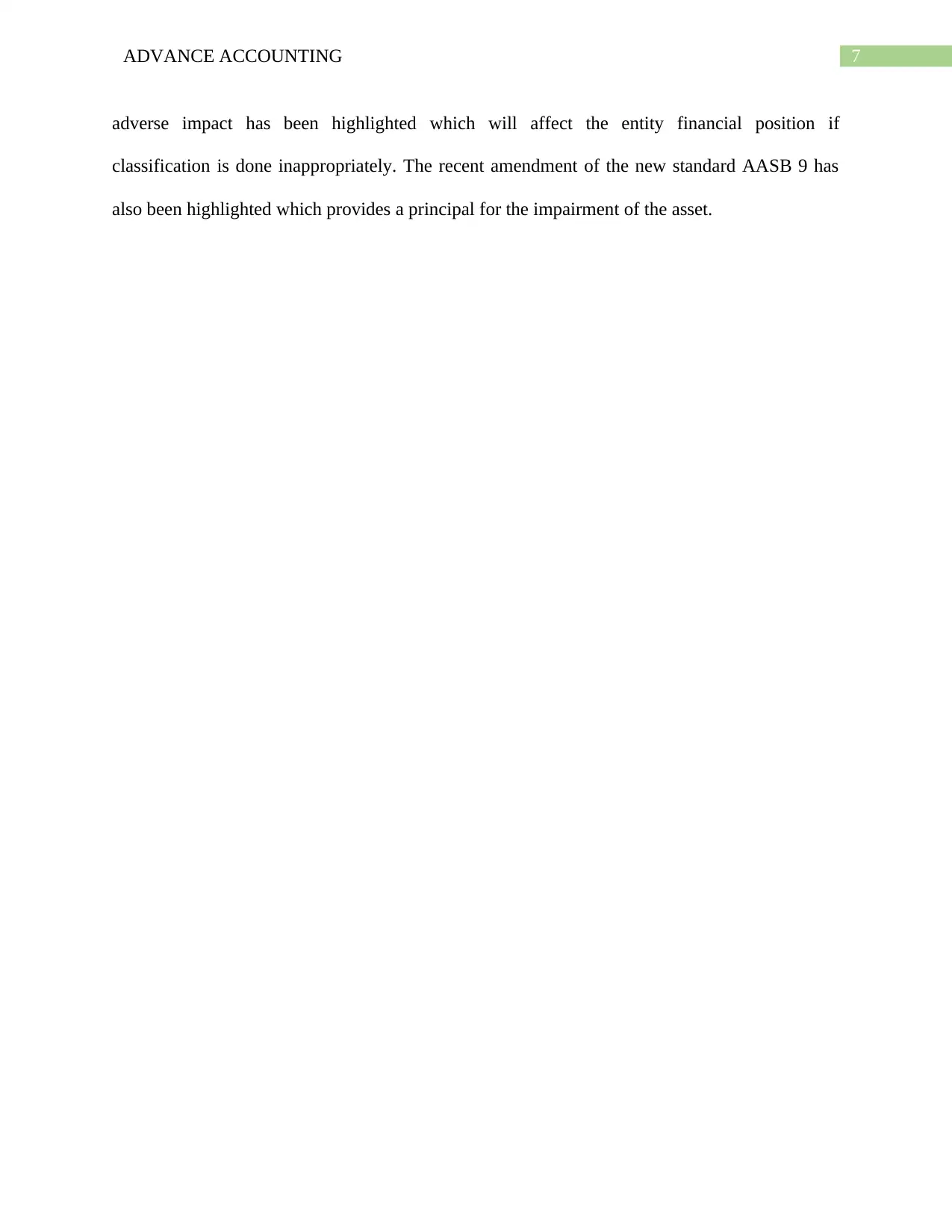
7ADVANCE ACCOUNTING
adverse impact has been highlighted which will affect the entity financial position if
classification is done inappropriately. The recent amendment of the new standard AASB 9 has
also been highlighted which provides a principal for the impairment of the asset.
adverse impact has been highlighted which will affect the entity financial position if
classification is done inappropriately. The recent amendment of the new standard AASB 9 has
also been highlighted which provides a principal for the impairment of the asset.
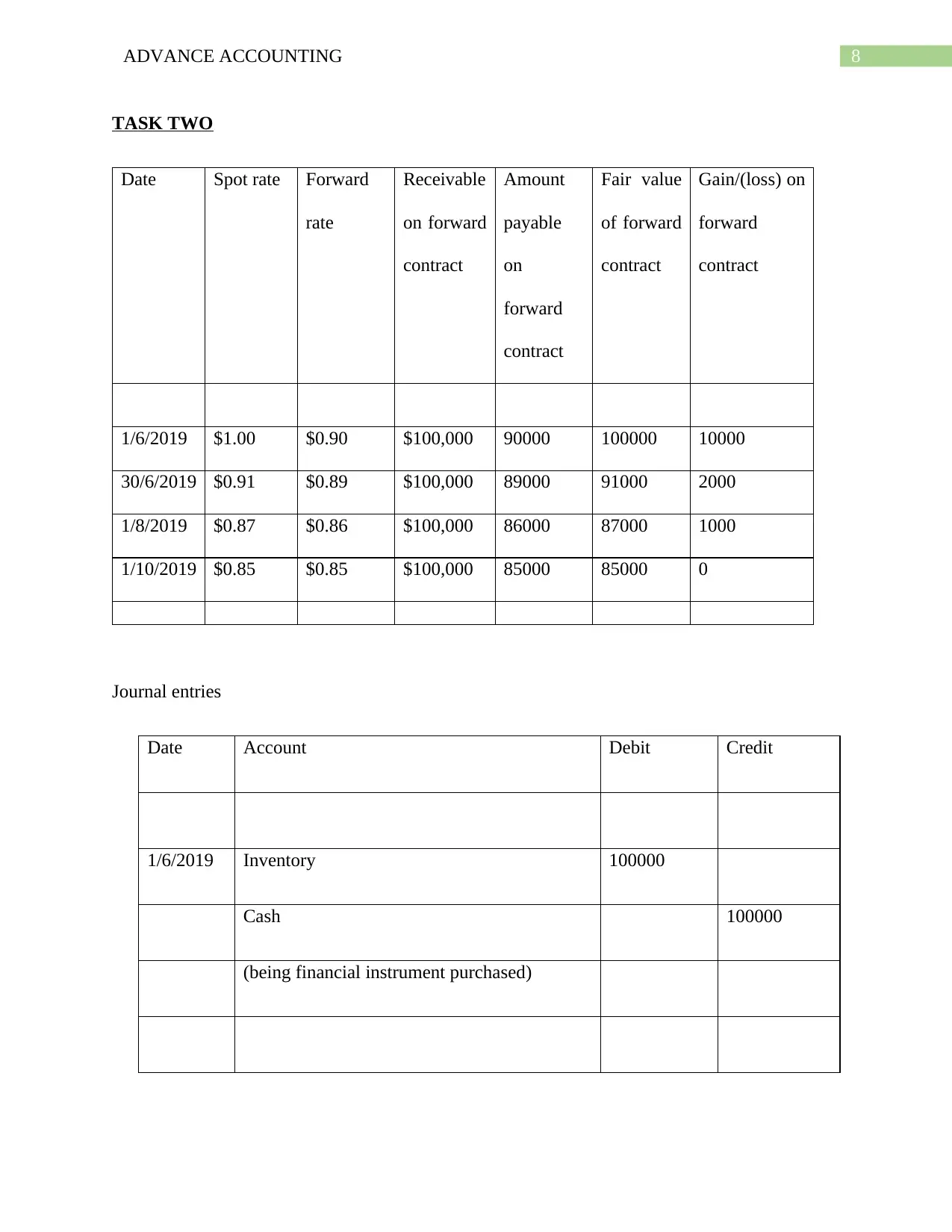
8ADVANCE ACCOUNTING
TASK TWO
Date Spot rate Forward
rate
Receivable
on forward
contract
Amount
payable
on
forward
contract
Fair value
of forward
contract
Gain/(loss) on
forward
contract
1/6/2019 $1.00 $0.90 $100,000 90000 100000 10000
30/6/2019 $0.91 $0.89 $100,000 89000 91000 2000
1/8/2019 $0.87 $0.86 $100,000 86000 87000 1000
1/10/2019 $0.85 $0.85 $100,000 85000 85000 0
Journal entries
Date Account Debit Credit
1/6/2019 Inventory 100000
Cash 100000
(being financial instrument purchased)
TASK TWO
Date Spot rate Forward
rate
Receivable
on forward
contract
Amount
payable
on
forward
contract
Fair value
of forward
contract
Gain/(loss) on
forward
contract
1/6/2019 $1.00 $0.90 $100,000 90000 100000 10000
30/6/2019 $0.91 $0.89 $100,000 89000 91000 2000
1/8/2019 $0.87 $0.86 $100,000 86000 87000 1000
1/10/2019 $0.85 $0.85 $100,000 85000 85000 0
Journal entries
Date Account Debit Credit
1/6/2019 Inventory 100000
Cash 100000
(being financial instrument purchased)
⊘ This is a preview!⊘
Do you want full access?
Subscribe today to unlock all pages.

Trusted by 1+ million students worldwide

9ADVANCE ACCOUNTING
1/6/2019 Financial Instrument 100000
Inventory 100000
(Being inventory considered as financial
instrument)
1/6/2019 Financial instrument
10,000
Other comprehensive income 10000
(Being gain on foreign exchange)
30/6/2019 Inventory 2000
Other comprehensive income 2000
(being gain on foreign exchange)
1/8/2019 Financial 1000
Other comprehensive income 1000
(being gain on foreign exchange)
1/10/2019 Cash
1/6/2019 Financial Instrument 100000
Inventory 100000
(Being inventory considered as financial
instrument)
1/6/2019 Financial instrument
10,000
Other comprehensive income 10000
(Being gain on foreign exchange)
30/6/2019 Inventory 2000
Other comprehensive income 2000
(being gain on foreign exchange)
1/8/2019 Financial 1000
Other comprehensive income 1000
(being gain on foreign exchange)
1/10/2019 Cash
Paraphrase This Document
Need a fresh take? Get an instant paraphrase of this document with our AI Paraphraser
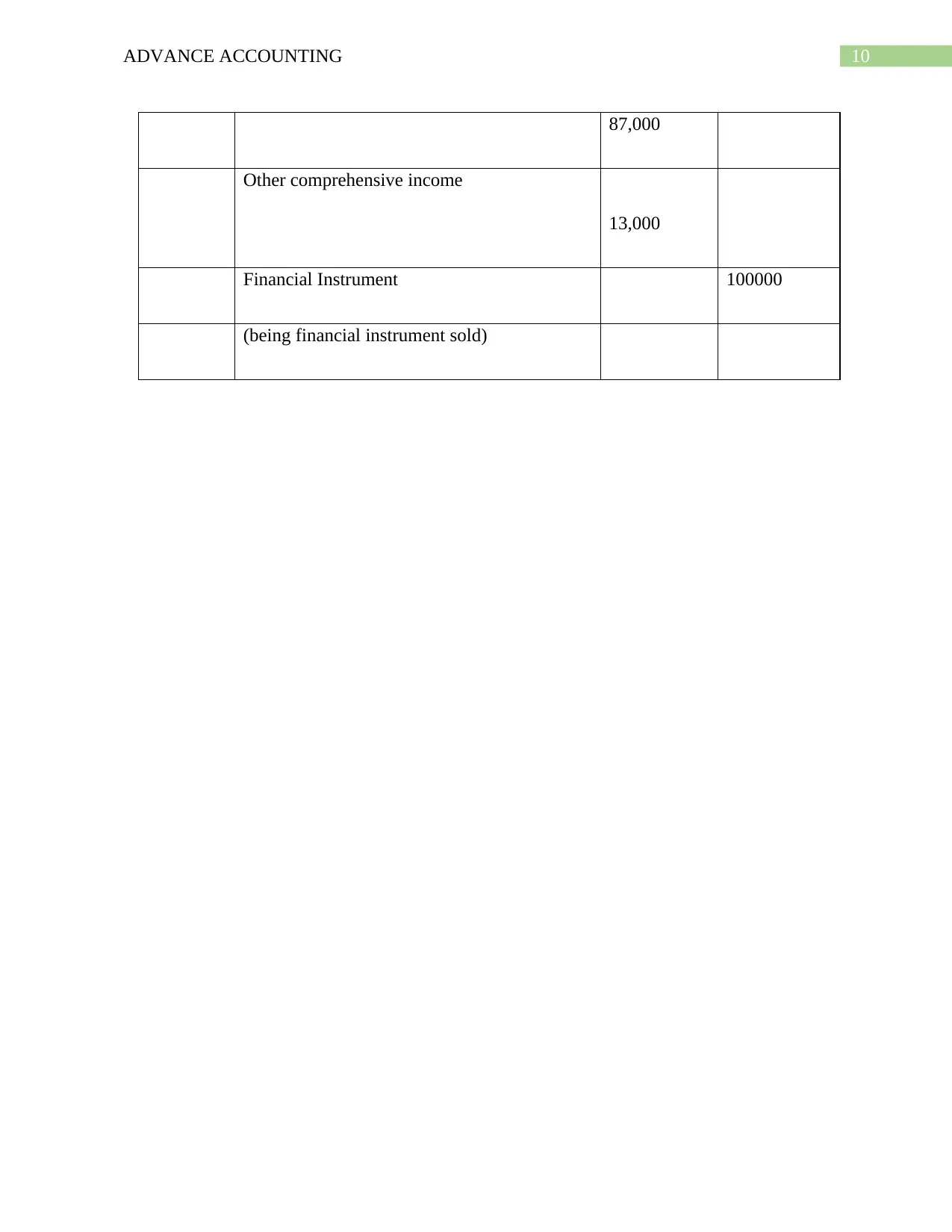
10ADVANCE ACCOUNTING
87,000
Other comprehensive income
13,000
Financial Instrument 100000
(being financial instrument sold)
87,000
Other comprehensive income
13,000
Financial Instrument 100000
(being financial instrument sold)

11ADVANCE ACCOUNTING
Reference
Das, S.C., 2015. The Financial System in India: Markets, Instruments, Institutions, Services and
Regulations. PHI Learning Pvt. Ltd.
Fabozzi, F.J. ed., 2018. The handbook of financial instruments. John Wiley & Sons.
Iasplus.com. (2020). IAS 32 — Financial Instruments: Presentation.
https://www.iasplus.com/en/standards/ias/ias32.
Maglio, R., Agliata, F. and Tuccillo, D., 2017. Trend of IASB Project on the Distinction between
Equity and Liabilities: The Case for Cooperatives and Continental European Firms.
Mullinova, S., 2016. Use of the principles of IFRS (IAS) 39" Financial instruments: recognition
and assessment" for bank financial accounting. Modern European Researches, (1), pp.60-64.
Pwc.com. (2020). Available at:
https://www.pwc.com/gx/en/ifrs-reporting/pdf/financial_instruments_guide_maze.pdf
Skoglund, J. and Chen, W., 2015. Financial risk management: Applications in market, credit,
asset and liability management and firmwide risk. John Wiley & Sons.
Tan, B.S. and Low, K.Y., 2017. Bitcoin–its economics for financial reporting. Australian
Accounting Review, 27(2), pp.220-227.
Uyar, A., Kılıç, M. and Gökçen, B.A., 2016. Compliance with IAS/IFRS and firm
characteristics: evidence from the emerging capital market of Turkey. Economic research-
Ekonomska istraživanja, 29(1), pp.148-161.
Wild, K., Creighton, B. and Simmonds, A., 2015. Gaap 2000: UK Financial Reporting. Springer.
Reference
Das, S.C., 2015. The Financial System in India: Markets, Instruments, Institutions, Services and
Regulations. PHI Learning Pvt. Ltd.
Fabozzi, F.J. ed., 2018. The handbook of financial instruments. John Wiley & Sons.
Iasplus.com. (2020). IAS 32 — Financial Instruments: Presentation.
https://www.iasplus.com/en/standards/ias/ias32.
Maglio, R., Agliata, F. and Tuccillo, D., 2017. Trend of IASB Project on the Distinction between
Equity and Liabilities: The Case for Cooperatives and Continental European Firms.
Mullinova, S., 2016. Use of the principles of IFRS (IAS) 39" Financial instruments: recognition
and assessment" for bank financial accounting. Modern European Researches, (1), pp.60-64.
Pwc.com. (2020). Available at:
https://www.pwc.com/gx/en/ifrs-reporting/pdf/financial_instruments_guide_maze.pdf
Skoglund, J. and Chen, W., 2015. Financial risk management: Applications in market, credit,
asset and liability management and firmwide risk. John Wiley & Sons.
Tan, B.S. and Low, K.Y., 2017. Bitcoin–its economics for financial reporting. Australian
Accounting Review, 27(2), pp.220-227.
Uyar, A., Kılıç, M. and Gökçen, B.A., 2016. Compliance with IAS/IFRS and firm
characteristics: evidence from the emerging capital market of Turkey. Economic research-
Ekonomska istraživanja, 29(1), pp.148-161.
Wild, K., Creighton, B. and Simmonds, A., 2015. Gaap 2000: UK Financial Reporting. Springer.
⊘ This is a preview!⊘
Do you want full access?
Subscribe today to unlock all pages.

Trusted by 1+ million students worldwide
1 out of 13
Related Documents
Your All-in-One AI-Powered Toolkit for Academic Success.
+13062052269
info@desklib.com
Available 24*7 on WhatsApp / Email
![[object Object]](/_next/static/media/star-bottom.7253800d.svg)
Unlock your academic potential
Copyright © 2020–2025 A2Z Services. All Rights Reserved. Developed and managed by ZUCOL.





